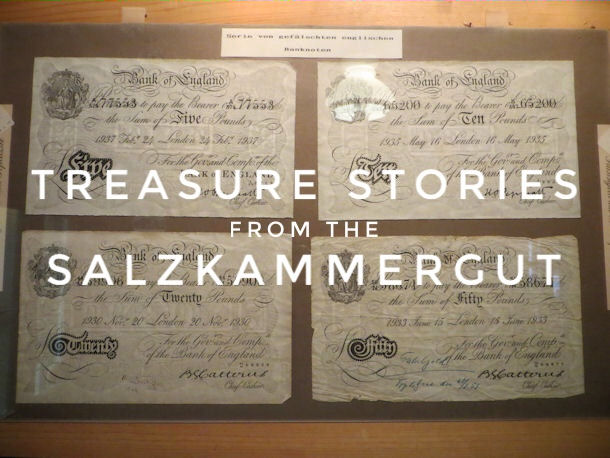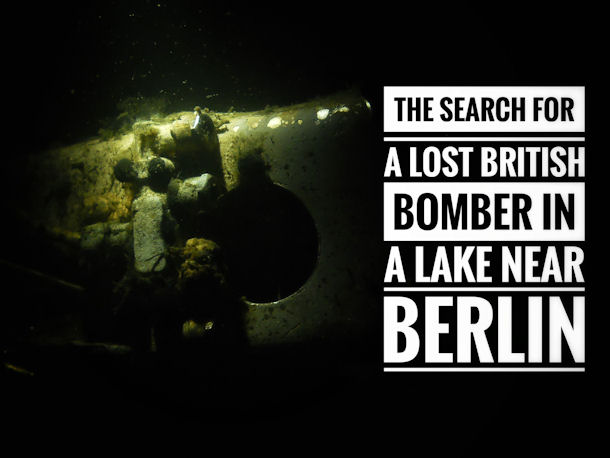X Marks the Spot
The Hunt for Lake Stolpsee’s Nazi Gold
|
|
One particularly fascinating diving spot just an hour and half drive from Berlin is Lake Stolpsee. With a 371-hectare surface area, it’s the largest lake in the Uckermarks Lakes Nature Park. It is sandwiched between the town of Fürstenberg/Havel and the small village of Himmelpfort. The latter, which is located on the lake’s north eastern shore, is perhaps best known as Germany’s number one postal address for letters to Santa Claus, and also for its ruins of an ancient Cistercian monastery.
|
|
The site, founded in 1299 by the Elector of Brandenburg Margrave Albrecht III, was originally run by Cistercian monks from the Brandenburg Abbey of Lehnin, but it was dissolved in 1541. However, the lake holds a much larger secret...
|
|
Ruins of an ancient Cistercian monastery
|
|
Lake Stolpsee takes its name from the old fishing village of Stolp, which used to sit east of the mouth of the river Woblitz before its decimation during the Middle Ages. The name "Stolp" has its origins in the Slavic term for "stick" and apparently refers to an alternative method of fishing similar to today's fish traps. The lake itself is incredibly rich in fish, and it’s not only the German regulars such as pike, carp, zander, tench and catfish that live here: rare species also inhabit these waters, such as gudgeon and the European smelt.
|
|
There are two peninsulas in the southeast of Lake Stolpsee that form the so-called "Crayfish Bay". East of the Knief peninsula lies a small island. Wooden constructions, shards of Slavic crockery, animal bones, an iron knife and other signs of human development have been discovered on its shores. Perhaps they are the remnants of a bridge to the Knief peninsula, or the remains of a late Slavic island settlement. As far as can be seen, no detailed exploration of the island has taken place so far.
|
|
Nazi treasure said to lurk at the bottom of Lake Stolpsee
|
|
And this particular body of water continues to attract treasure hunters and divers to the lake. The following story of lost Nazi loot persists: It is believed that Hermann Göring ordered several boxes of gold and platinum to be dumped in the lake shortly before the end of the Second World War. In March 1945, a former Luftwaffe aide from Göring's precinct is said to have observed an SS unit drive a truck to the shore of Lake Stolpsee: apparently a group of 20 to 30 men in prisoner clothing loaded heavy crates onto rubber dinghies before sinking them in a bay in the lake.
|
|
There is even a real treasure map. It shows the lake and near it, a house standing in the forest. To the left of the house, two tree stumps are depicted alongside an oversized nail. The nail is hammered into one of these tree stumps, and forms an 85-degree angle, with one leg of the angle pointing to a house on the northern shore of the lake that bears a cross on the ridge of its roof. To the left of it, the word "Petrus" is written - possibly a reference to the Cistercian monastery of Himmelfort.
|
|
The GDR’s Stasi also hunted for the Nazi gold under the code name "Autumn Wind"
|
|
During the days of the GDR, Stasi intelligence services had already started to search for the lost treasure. In 1981, the editor of the German weekly Stern Gerd Heidemann (incidentally, the same editor who later acquired the fake Hitler diaries from the forger Konrad Kujau) presented the Stasi with a treasure map allegedly showing the way to the lost loot and struck a deal with the ministry. The "Office for the Legal Protection of the Property of the GDR" assured him of a 50 percent share of the gold on discovery of the valuables in Lake Stolpsee. Of course, his prize would be tax-free. It was further agreed "that a journalistic evaluation will not be carried out until the recovery of all objects described in the information provided has been completed". Following the agreement, Heidemann set out on a treasure hunt together with the comrades of the Ministry of State Security.
|
The then Head of the Stasi Erich Mielke himself is said to have approved the treasure hunt, which was given the code name "Autumn Wind". For him, the search at Lake Stolpsee was of the highest priority. Personnel from Department IX/7 worked their way through mountains of archive documents, studied maps and photos, examined documents from all departments of the Nazi regime around Göring’s residence of Carinhall and interviewed elderly residents in the municipality of Schorfheide. It was established that a small house on the opposite shore of the lake had indeed born a cross on the ridge of its roof until shortly after the end of the war. But with only this one clue, it was impossible to guess the angle and therefore the key to the treasure map. Heidemann and his Stasi personnel were left to search in vain for the nail in the tree stump on the lakeshore.
|
|
In 1982, specialists from the Operative-Technical Sector (OTS) and the special forces of the Geophysics Department investigated the lake. Mielke allegedly also ordered the use of a multi-spectral camera to try and photograph the alleged site of the treasure trove from an aircraft. Three remarkable elevations are said to have been discovered in the Stolpsee bay. Divers from the "Feliks Dzierzynski" guard regiment searched the muddy bottom of the lake for months. However, nothing was found and the Stolpsee treasure map disappeared into the Stasi archives.
|
|
Since the fall of communism, new and often large-scale searches have been repeatedly carried out. The Israeli Nazi treasure hunter Yorav Svoray searched the bottom of the lake. His search also proved unsuccessful. However, as long as the gold remains unaccounted for, the legend of the treasure in the Stolpsee will live on.
|
|
Around the lake there are some small swimming sites that can be used as entry points for divers. At the eastern shore near Himmelpfort, the lake has a far-reaching shallow area, but then drops steeply. With every dive, the hope remains that a lucky individual may come across one of the mysterious boxes of gold. And by the way: if you find a rusty nail in a tree stump during a walk on the lake, feel free to contact me...
|
|
References:
Andreas Förster, „Schatzräuber – Die Suche der Stasi nach dem Gold der Nazizeit“, 1. Auflage, Christoph Links Verlag, S. 108 ff.
Andreas Förster, „Der Schatz im Stolpsee“ in Berliner Zeitung vom 23. Januar 2008.
Peter-Ferdinand Koch, „Der Fund – Die Skandale des Stern, Gerd Heidemann und die Hitler-Tagebücher“, Verlag Facta Oblita GmbH, 1990, S. 728 ff.
|
|
|
Could be interesting for you:
|

Treasure Stories from the Salzkammergut (Austria)
The Salzkammergut. This region in northern Austria, around the towns of Bad Ischl and Hallstatt, was a refuge for many prominent Nazi figures during the last days of World War II. Rumours quickly spread of embezzled money, war coffers and gold that had been left at the bottom of Salzkammergut’s lakes. Since then, divers and treasure hunters from all over the world have come to the Salzkammergut to seek their illicit fortunes.
[read more]
|
|

The Search for a Lost British Bomber in a Lake near Berlin
At the beginning of World War II, Commander-in-Chief of the German Luftwaffe Hermann Göring declared during a radio address: "No enemy bomber can reach the Ruhr. If one reaches the Ruhr, my name is not Göring. You may call me Meyer.” However, only a few years later, Adolf Hitler’s trusted advisor and war-chief was forced to make good on his promise. In 1940, Göring apparently introduced himself as Herr Meyer on arrival at a Berlin air-raid shelter while taking refuge from one of the many Allied bomber units that had started to decimate Germany’s cities.
[read more]
|
|
|
The opinions of other divers are both incredibly interesting and helpful to us. Through the experiences of other travellers, we have been able to uncover many useful tips and gain wonderful insight into other countries, as well as finding out about accommodation, the local community, and various activities, all in advance of arriving at our planned destination. Therefore, we would be very pleased to receive any other travel reports on the topic of diving & snorkelling in Germany, which we would gladly present here on our website. Simply contact us at info @ easydive24.de
|
|
|
|

